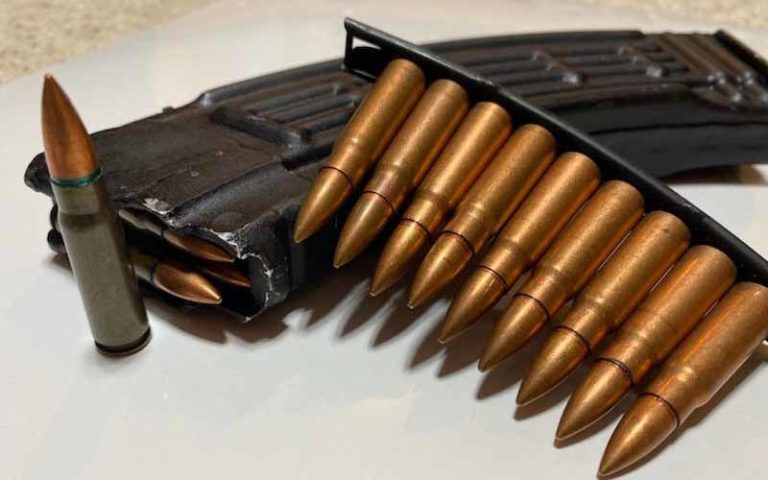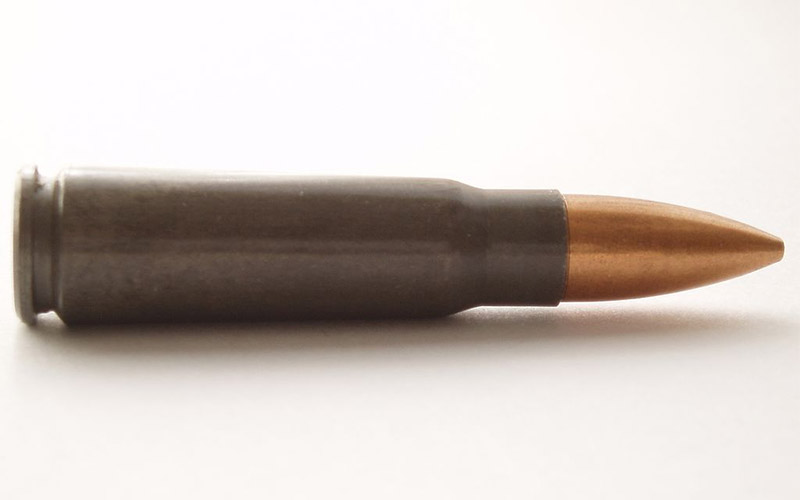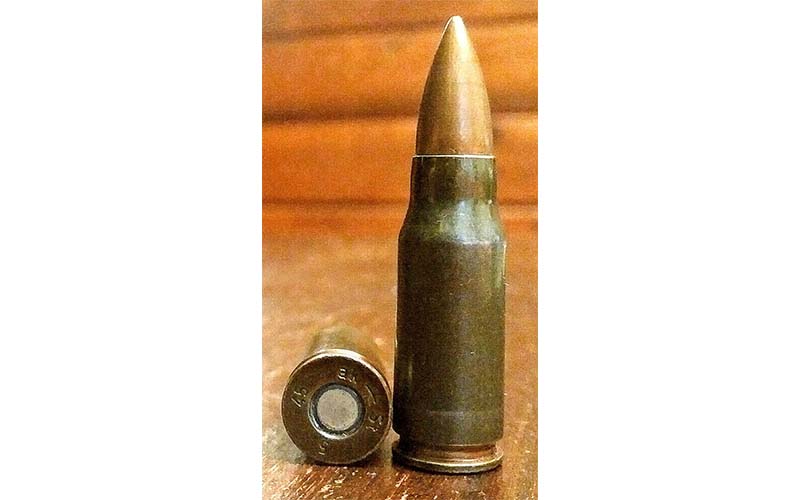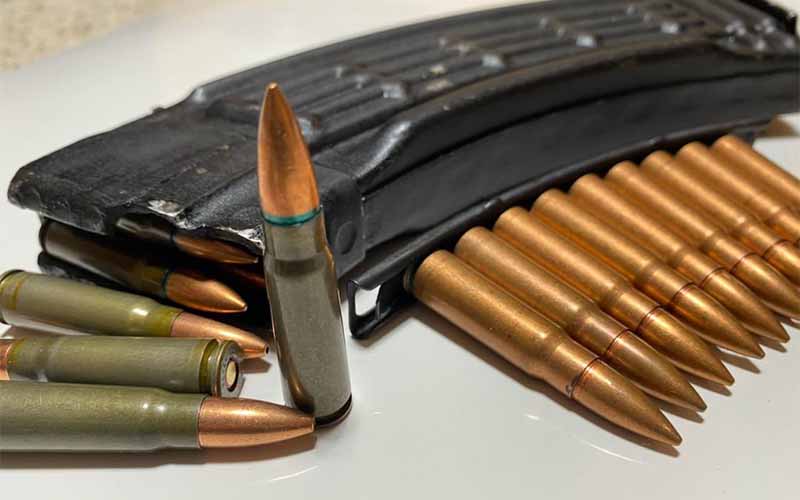
7.62×39, 7.62 Soviet, M43, this cartridge goes by many names, but regardless of what you call it it’s worth knowing about this prolific intermediate caliber round still used the world over.
7.62×39 may be the best example of the intermediate cartridge done right. The German 8mm Kurz that inspired it was close, and newer lightweight projectile cartridges like 5.56 have their advantages too, but when it comes to being a true “intermediate” round, 7.62×39 takes the cake.
Primarily known as the cartridge used by the ubiquitous AKM, 7.62×39 has led an interesting existence since its inception in 1943. Much like the rifle that uses it, this round has been so mass-produced that it will almost certainly outlast humanity’s reign over this planet. When the last war has been fought, there will still be unopened cans of 7.62×39 collecting dust on warehouse shelves across the world.
Because of its relative abundance, the use of this cartridge by fighters across the third world is a no-brainer, but what does it have to offer the modern American gun owner? Whether your interest in firearms has led you to become a hunter, a prepper or just a recreational shooter, there are still reasons to own and shoot 7.62×39.

Developing 7.62×39
The first iteration of what we would consider a modern intermediate cartridge was created by the Germans during WWII. Their experiences in the war so far had revealed that the range and accuracy capabilities of full-power rifle cartridges like 8mm Mauser were not being exploited in most combat settings. Engagements were happening at closer distances than the designers of old-school service rifles had anticipated, and the large and powerful ammunition they shot was typically more of a hindrance than an advantage. Understanding the benefits of more controllable automatic fire and a greater total ammunition loadout, the Germans cut down their standard infantry cartridge to create 8mm Kurz (short) for the StG 44.

The new cartridge and weapon combo turned the heads of small arms aficionados and military brass alike across the globe, and most countries began experimenting with similar concepts as well. The Soviet Union was no exception, and their efforts yielded what can easily be regarded as the most successful intermediate cartridge ever created: 7.62×39.
This cartridge was part of a greater modernization and standardization attempt by the USSR, intending to replace their existing stockpile of Mosin Nagants, SVT-40s, PPS-43s and DPMs with a fresh family of weapons that all used the new 7.62×39 cartridge. Those weapons were a semi-automatic carbine that became the SKS, a light machinegun that became the RPD, a bolt-action reserve rifle that was abandoned and a “submachine gun” that became the AK.
There was plenty of testing, experimenting and changing that took place between 1943 and 1947 when 7.62×39 was finalized, but the resultant cartridge accomplished exactly what the Soviets had intended.
7.62×39 Performance And Usefulness
The original and most prototypical loading for 7.62×39 is known as M43, a steel-cased round with a 123-grain boat-tail FMJ bullet that has a steel core and a copper-plated jacket. When fired out of a standard 16-inch AK, this round has an average muzzle velocity of about 2,350 feet per second, delivering about 1,500 foot-pounds of energy. Another advantage of this round is its performance out of shorter barreled carbines. Lighter “intermediate” rounds like 5.56 and 5.45 lose a lot of velocity (and therefore effectiveness) when fired out of short barrels, but 7.62×39 loses a minimal amount of velocity in comparison. This makes 7.62 Soviet an excellent candidate for SBR builds or pistols.
7.62×39 cartridges have a very aggressive taper to them, which is what gives AK magazines their iconic “banana” curve. This taper has also helped contribute to the AK’s reputation for reliability, however, as it lends itself extremely well to feeding and extracting. While all AK-platform guns are very reliable, none are as reliable as the 7.62×39 variants.

As a military round, 7.62×39 has received some criticisms as well. It typically doesn’t fragment upon impacting a soft target, instead either passing straight through or tumbling once inside. While this is not as devastating of an effect as a 5.56 round that’s traveling fast enough to fragment, 7.62 instead offers better barrier penetration and more stability in flight. A tradeoff that still apparently has value on the 21st century battlefield, as even some Spetsnaz in Syria and other modern warfighters have been seen opting for 7.62 AKs to fill certain roles. Besides having better barrier penetration, this round suppresses better as well. While 7.62 may not be able to produce the same extreme cavitation that 5.56 can, history has proved that it’s still plenty effective at doing its job.
Just like AKMs, 7.62×39 ammunition has been produced by nearly countless countries over the years, resulting in a lot of variation. Most military ammo is steel-cased and has some amount of steel in the core as well, while commercial ammo (both domestic and imported) typically has a lead core. Commercial ammo can be either brass or steel-cased depending on where it’s from, and it’s available with a wider variety of projectiles. Soft-point rounds are popular for hunting deer-sized game, and ballistic-tipped hollow points are made by some companies for defense too.

A lot of the surplus military ammo that used to be available used corrosive primers, which if shot could corrode the barrel if left uncleaned. These days corrosive ammo on the U.S. commercial market is quite rare, but it’s something to keep in mind when shooting surplus, especially Yugoslavian.
Besides being extremely abundant around the globe, 7.62×39 is still appreciated by its users for its performance as well. It’s considered to be a good, reliable, jack-of-all-trades round that provides good enough accuracy and stopping power to be effective in most combat situations. It’s no sniper’s round, often described as being only “minute-of-man” capable, but in most environments that’s all you really need.
Half of this round’s appeal in the U.S. for a very long time was its price, especially when compared to .223, but unfortunately, that is no longer the case. As of writing this, the two calibers are virtually the same price per round, but fans of 7.62 still have hope that actions by some companies like PSA in the future will help to restore the natural order.

Despite now being almost 80 years old, 7.62×39 is still going strong. Enough has already been produced that it could probably fuel the next century of human conflict alone, yet more gets made every day. It has no chance of falling out of style with either military or civilian users and will continue to see heavy use around the world for the foreseeable future. It has several merits that go beyond its abundance, however, and it still serves well as a do-it-all cartridge in a variety of roles and weapon systems. Whether you’re a hunter, a prepper or just enjoy plinking cartridges with an interesting history, don’t forget about 7.62×39.
More Combloc Guns And Ammo
- 5.45x39mm And The AK-74
- The full-power7.62x54R
- Ammo Brief: 9×18 Makarov
- 7.62x25mm And Tokarev Pistols
- The End Of An Era: The Russian Ammo Ban

Next Step: Get your FREE Printable Target Pack
Enhance your shooting precision with our 62 MOA Targets, perfect for rifles and handguns. Crafted in collaboration with Storm Tactical for accuracy and versatility.
Subscribe to the Gun Digest email newsletter and get your downloadable target pack sent straight to your inbox. Stay updated with the latest firearms info in the industry.

![Best Concealed Carry Guns In 2025 [Field Tested] Wilson Combat EDC X9S 1](https://gundigest.com/wp-content/uploads/Wilson-Combat-EDC-X9S-1-324x160.jpg)


![Best 9mm Carbine: Affordable PCCs [Tested] Ruger Carbine Shooting](https://gundigest.com/wp-content/uploads/Ruger-Carbine-Shooting-100x70.jpg)
![Best AR-15: Top Options Available Today [Field Tested] Harrington and Richardson PSA XM177E2 feature](https://gundigest.com/wp-content/uploads/Harrington-and-Richardson-PSA-XM177E2-feature-100x70.jpg)

Great cartridge but only within 200 meters.
The 800m adjustable sight on any AK is just wishful thinking…
800m may be a bit wishful for iron sights, but a competent marksman can ring steel with them at 500m all day long. You can find videos online showing this, proving the cartridge has sufficient accuracy and range to do so.
A great article.
This cartridge is still so popular that many firearms manufacturers chamber their rifles for it. At last count, Ruger, Howa, CZ, & Savage make bolt action rifles for this caliber. Add in MSR’s, AR conversion kits, single shot top breaks, all support this great round.
Perhaps one of the lever action rifle makers will chamber this round & finally sound the death knell of the inferior 30-30.
It’s true, firearms are likely to be obsolete before supplies of this one are exhausted, but supply is only part of the equation. The issue we’re all experiencing right now is lack of distribution. I recall that, during the last panic buying spree, this one was just as hard to find as .223 and 9mm. Still, I wish I’d picked up a Mini 30 back when they were easy to find and affordable. Ah, yes, hindsight…